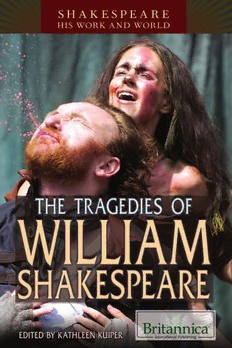
The tragedies of William Shakespeare PDF
Preview The tragedies of William Shakespeare
Published in 2013 by Britannica Educational Publishing (a trademark of Encyclopædia Britannica, Inc.) in association with Rosen Educational Services, LLC 29 East 21st Street, New York, NY 10010. Copyright © 2013 Encyclopædia Britannica, Inc. Britannica, Encyclopædia Britannica, and the Thistle logo are registered trademarks of Encyclopædia Britannica, Inc. All rights reserved. Rosen Educational Services materials copyright © 2013 Rosen Educational Services, LLC. All rights reserved. Distributed exclusively by Rosen Educational Services. For a listing of additional Britannica Educational Publishing titles, call toll free (800) 237-9932. First Edition Britannica Educational Publishing J.E. Luebering: Senior Manager Adam Augustyn: Assistant Manager Marilyn L. Barton: Senior Coordinator, Production Control Steven Bosco: Director, Editorial Technologies Lisa S. Braucher: Senior Producer and Data Editor Yvette Charboneau: Senior Copy Editor Kathy Nakamura: Manager, Media Acquisition Kathleen Kuiper: Senior Editor, Arts and Culture Rosen Educational Services Jeanne Nagle: Senior Editor Nelson Sá: Art Director Cindy Reiman: Photography Manager Amy Feinberg: Photo Researcher Brian Garvey: Designer and Cover Design Introduction by J.E. Luebering Library of Congress Cataloging-in-Publication Data The tragedies of William Shakespeare/edited by Kathleen Kuiper.—1st ed. p. cm.—(Shakespeare: his work and world) “In association with Britannica Educational Publishing, Rosen Educational Services.” Includes bibliographical references and index. ISBN 978-1-61530-932-0 (eBook) 1. Shakespeare, William, 1564-1616—Tragedies. I. Kuiper, Kathleen. PR2983.T67 2013 822.3’3—dc23 2012021217 On the cover: One of three prophesying witches revealing a bloody future for the title character, played by actor Antony Byrne, in a London production of Macbeth, in 2007. Elliott Franks/WireImage/Getty Images Pages 1, 17, 26, 44, 82 Hulton Archive/Getty Images Introduction ix 1 Contents Shakespeare and the Liberties 1 “We Will Play” 1 The Perception of Performance 2 Globe Theatre 4 The “Liberties” of London 6 Bearbaiting 7 City Playhouses 10 The View of Actors 12 The Popular Stage 14 Performance in Shakespeare’s Theatre 17 11 Plays Within Plays 18 The Early Plays 19 Pyramus and Thisbe 20 The Internal Play in Hamlet 21 The Internal Play in The Tempest 23 Moral Regeneration Through Illusion 25 Tragedy in Shakespeare’s Time 26 ElizabethanTragedy 27 Christopher Marlowe and the First Christian Tragedy 30 38 Christopher Marlowe 31 Shakespearean Tragedy 34 From Comedy to Tragedy 35 The Fates 38 Shakespeare’s Tragic Art 39 Decline in 17th-Century England 41 5588 56 Inside the Plays: Shakespeare’s Tragedies 44 Revenge Tragedy 45 The Early Tragedies 45 Titus Andronicus 46 Thomas Kyd 48 Romeo and Juliet 50 West Side Story 51 Julius Caesar 52 Julius Caesar the Man 53 The Great Tragedies 54 Hamlet 55 Othello 59 68 68 King Lear 62 Hamartia 63 Leir 66 Macbeth 67 Macbeth the Man 70 Antony and Cleopatra 71 Cleopatra Through the Ages 73 Other Tragedies 74 Timon of Athens 75 Coriolanus 77 Troilus and Cressida 79 Conclusion 82 8844 78 Glossary 83 Bibliography 85 Index 87 Introduction W illiam Shakespeare’s tragedies, such as Hamlet, King Lear, and Macbeth, are considered by many to be the greatest achievements in the history of the written word. That is not an honour lightly bestowed. Shakespeare’s reputation as arguably the greatest writer of all time has been commonly accepted for centuries. Yet these tragedies are not simply esteemed because they are well-known products of a famous name that have gained exalted status through historical repetition. Rather, they represent the pinnacle of literary insight into most every facet of the human psyche. As detailed in the pages of this book, these plays continue to move and beguile both scholars and non-scholars to the present day. The lasting iconic reputation of Shakespeare’s tragic plays is primarily based on those works collec- tively known as the “great tragedies,” a grouping of plays that typically consists of Hamlet, Othello, King Lear, Macbeth, and Antony and Cleopatra. But his tragic oeuvre is much larger and more varied than just those five dra- mas. His earliest tragedy, Titus Andronicus, was one of the first plays he ever composed and certainly the most grotesquely violent. An account of the betrayal of the titular Roman general, who brutally avenges the daugh- ter raped and mutilated by his enemies, the surpassingly bloody work (by Shakespearean standards, at least) was in the spirit of the graphic melodramas that were popu- lar in the late 16th century. Composite showing actor David Garrick performing as the title char- acter in three of William Shakespeare’s great tragedies—King Lear, Macbeth, and Othello—as well as the history play Richard III. The Bridgeman Art Library/Getty Images e ix f
